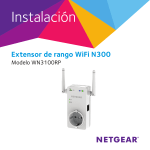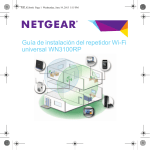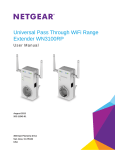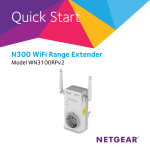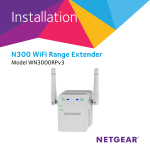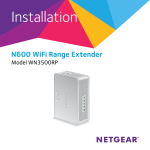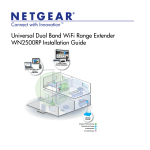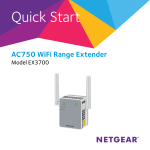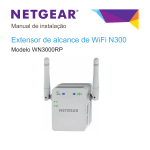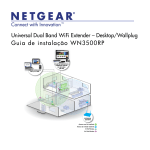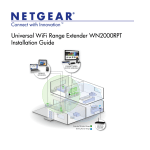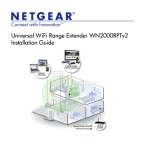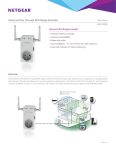Download Netgear WN3100RP Installation Guide
Transcript
Installation N300 WiFi Range Extender Model WN3100RP Getting Started The NETGEAR WiFi Range Extender increases the distance of a WiFi network by boosting the existing WiFi signal and enhancing the overall signal quality over long distances. An extender repeats the signals from an existing WiFi router or access point. 2 Meet Your Extender Before you install your extender, familiarize yourself with its LEDs, buttons, and port. Front and Right Side Panels Router Arrow LED Client Arrow LED Router Link LED Client Link LED Power LED WPS LED Ethernet port Pass-through power socket (varies by region) 3 Rear and Left Side Panels WPS button Product label Factory Reset button Device On/Off switch Power connector (varies by region) 4 LED Descriptions Router Link LED This LED indicates the connection between the extender and the router or access point. Solid green. Best connection. Solid amber. Good connection. Solid red. Poor connection. Off. No connection. Client Link LED This LED indicates the connection between the extender and a computer or WiFi device. Solid green. Best connection. Solid amber. Good connection. Solid red. Poor connection. Off. No connection. Power LED Solid amber. The extender is booting. Solid green. The extender is powered on. Off. The extender is powered off. WPS LED Solid green. WiFi security is enabled (WPA or WPA2). Blinking green. A WPS connection is in progress. Off. WiFi security is not enabled. Note: If the Router Arrow LED or Client Arrow LED blinks, see Find the Best Location on page 13. If no arrow LEDs light, the extender is in a good location. 5 Install the WiFi Extender Place the extender, apply power, and connect it to your WiFi network. Place the Extender and Apply Power 1. Place your extender in the same room as your WiFi router. Proximity to the WiFi router is required only during the initial setup process. 2. Plug the extender into an electrical outlet. The Power LED lights green. If the Power LED does not light, slide the Device On/Off switch on the side of the extender to the On position. Connect to an Existing WiFi Network To extend the range of your WiFi network, you must connect the extender to your existing WiFi network. You can do this in one of two ways: • • Connect with WPS. For more information, see Connect with WPS on page 7. Connect with web browser setup. For more information, see Connect with Web Browser Setup on page 9. 6 Connect with WPS Wi-Fi Protected Setup (WPS) lets you join a secure WiFi network without typing the network name and password. Note: WPS does not support WEP network security. If you are using WEP security, follow the instructions in Connect with Web Browser Setup on page 9. 1. Press the WPS button on the side panel of the extender. The WPS LED blinks. 2. Within two minutes, press the WPS button on your router or access point. The WPS LED on the extender lights solid green, the Router Link LED lights, and the extender connects to your existing WiFi network. If the Router Link LED does not light, try again. If it still does not light, see Connect with Web Browser Setup on page 9. 3. Find the new extender network name on your computer or WiFi device. The extender’s wireless network name (SSID) changes to your existing WiFi network name, with _EXT at the end of the name, for example: • Existing WiFi network name. MyNetworkName • New extended network name. MyNetworkName_EXT 7 4. Connect your computer or WiFi devices to the new extended WiFi network. Use the same WiFi password that you use for your WiFi router. 5. Unplug the extender and move it to a new location closer to the area with a poor WiFi signal. The location that you choose must be within the range of your existing WiFi router network. 6. Plug the extender into an electrical outlet. lights green. If the Power LED does not light, The Power LED slide the Device On/Off switch on the side of the extender to the On position. 7. Use the Router Link LED on the front panel to help you choose a spot where the extender-to-router connection is optimal. 8 Connect with Web Browser Setup 1. Use a WiFi network manager on a computer or WiFi device to find and connect to the NETGEAR_EXT (SSID) WiFi network. After the connection with the computer or WiFi device is established, the Client Link LED lights. 2. Open a web browser window from the same computer or WiFi device. The browser takes you directly to the NETGEAR genie web browser setup. If you are not automatically directed to NETGEAR genie, launch a web browser and enter www.mywifiext.net in the address field. Enter admin for the user name and password for the password. The extender searches for WiFi networks in your area and displays a list. 9 3. Select a WiFi network to extend and click the Continue button. The following screen displays: 4. Type the network password (also called passphrase or security key) in the Password field and click the Continue button. The following screen displays: 10 5. In the Name field, type the name (SSID) for your new extender WiFi network and click the Continue button. You can use the same security settings as the settings for your existing network by selecting the check box. The settings are applied and the following screen displays. On iPads, iPhones, and MacBook computers, this screen automatically closes. 6. Use a WiFi network manager on the computer or WiFi device to connect to the extender’s newly created WiFi network. Repeat this step for all of your computers and WiFi devices. 11 7. If the screen is still displayed on your computer or WiFi device, select the check box at the bottom of the screen and click the Continue button. A message displays confirming that the extender is connected to the WiFi network. 8. Click the Finish button. 9. Unplug the extender and move it to a new location closer to the area with a poor WiFi signal. The location that you choose must be within the range of your existing WiFi router network. 10. Plug the extender into an electrical outlet. The Power LED lights green. If the Power LED does not light, slide the Device On/Off switch on the side of the extender to the On position. Use the Router Link LED to help you choose a spot where the extender-to-router connection is optimal. 12 Find the Best Location If the WiFi signal is weak, the first time you join the extender network, an arrow LED blinks for two minutes. If this happens, adjust the position of the extender. • If the Router Arrow LED the router. • If the Client Arrow LED blinks, move the computer or WiFi device closer to the extender. blinks, move the extender closer to If no arrow LEDs are lit, the extender is in a good location. 13 Connect an Ethernet-Enabled Device After the extender is connected to your existing WiFi network, you can connect a wired device to the extender using an Ethernet cable. That device can then access your existing network through the WiFi connection. WiFi router Extender Blu-ray player 1. Set up the extender. For more information, see Place the Extender and Apply Power on page 6. 2. Connect the extender to an existing WiFi network. For more information, see Connect to an Existing WiFi Network on page 6. 3. Plug the Ethernet cable from an Ethernet-enabled device in to the Ethernet port on the extender. 14 Log In to Access Extender Settings After installation, you can log in to the extender to view or change the extender’s settings. 1. Use a WiFi network manager on a computer or WiFi device to find and connect to the new extended WiFi network. After the connection with the computer or WiFi device is established, the Client Link LED lights. 2. Launch a web browser. 3. Enter www.mywifiext.net in the address field of the browser. A login screen displays. 4. Enter admin for the user name and password for the password. NETGEAR genie displays. 5. Make any needed changes. 15 Frequently Asked Questions You can find more information about your product in the user manual, which is available at http://support.netgear.com. The web browser setup guide keeps asking me for my network password (passphrase) or security key, and I am sure that I entered the correct password. What can I do? The extender is probably placed at the borderline of the range covered by the router or access point. For more information, see Place the Extender and Apply Power on page 6. If you are using WEP security, make sure that you are typing the network password in the correct field. My router security is WEP, and I entered the wrong passphrase or security key on the extender. I cannot access the extender anymore. What can I do? The extender cannot check to see if the WEP passphrase is correct. If you entered the wrong passphrase, your wireless device is not able to get the IP address from the extender. You must reset the extender to its factory default settings to get the IP address back. 16 How do I restore the extender to its factory default settings? 1. Use a sharp object such as a pen or paper clip to press and hold the Factory Reset button on the side of the extender for at least five seconds until the Power LED blinks amber. 2. Release the Factory Reset button and wait for the extender to reboot. The extender resets and returns to the factory default settings. You can now access the extender from your web browser using the factory default settings. Will the extender work if I connect it to the router with an Ethernet cable? No. The extender is designed to connect wirelessly to the router or access point. What are the user name and password to log in to the extender? The user name is admin, and the default password is password. Both are case-sensitive. 17 I enabled a wireless MAC filter, wireless access control, or access control list (ACL) on my router. What should I do when installing the extender? When the WiFi device connects through the extender to your router, the MAC address of the WiFi device shown on the router is translated to another MAC address. If your router’s MAC filter, wireless access control, or ACL is enabled, the WiFi device connects to the extender but cannot get an IP address from the extender and cannot access the Internet. To allow the WiFi device to receive an IP address from the extender and access the Internet, you must provide the translated MAC address to the router. 1. Log in to your router and disable the MAC filter, wireless access control, or ACL. For more information about how to disable your router’s MAC filter, wireless access control, or ACL, see your router’s documentation. 2. Power on the extender and connect all of your WiFi devices to the extender network. 3. Make sure that the Router Link LED remains lit. 4. Log in to your extender: a. Launch a web browser. b. Enter www.mywifiext.net in the address field of the browser. 18 A login screen displays. c. Enter admin for the user name and password for the password. 5. Select Maintenance > Attached Devices. The Attached Devices screen displays the MAC addresses and virtual MAC addresses for computers and WiFi devices that are connected to the extender network. 6. On the router, add all of the virtual MAC addresses from your extender to your router’s MAC filter table. 7. Enable the router’s MAC filter, wireless access control, or ACL. I am connected to NETGEAR_EXT and launched a browser. Why can’t I see the web browser setup guide? Try these troubleshooting steps: • Make sure that your computer is set up to use DHCP (most are). • Make sure that the Client Link LED is green and that you are using a valid IP address. • Relaunch the web browser and type www.mywifiext.net in the address field. Enter admin for the user name and password for the password. 19 Support Thank you for purchasing this NETGEAR product. After installing your device, locate the serial number on the label of your product and use it to register your product at https://my.netgear.com. You must register your product before you can use NETGEAR telephone support. NETGEAR recommends registering your product through the NETGEAR website. For product updates and web support, visit http://support.netgear.com. NETGEAR recommends that you use only the official NETGEAR support resources. You can get the user manual online at http://downloadcenter.netgear.com or through a link in the product’s user interface. Trademarks NETGEAR, the NETGEAR logo, and Connect with Innovation are trademarks and/or registered trademarks of NETGEAR, Inc. and/or its subsidiaries in the United States and/or other countries. Information is subject to change without notice. © NETGEAR, Inc. All rights reserved. Compliance For the current EU Declaration of Conformity, visit http://support.netgear.com/app/answers/detail/a_id/11621/. For regulatory compliance information, visit http://www.netgear.com/about/regulatory/. See the regulatory compliance document before connecting the power supply. NETGEAR, Inc. 350 East Plumeria Drive San Jose, CA 95134, USA September 2014




















